ADSactly Travels - Where the Highest Quality Arabica Coffee Comes From. Kenya Highlands Coffee Estate Tour
Where the Highest Quality Arabica Coffee Comes From. Kenya Highlands Coffee Estate Tour
I watch as the coffee pours from the pot to my cup. A dash of milk and sugar and a small stir makes it perfect. There is a moment of silence as we all savor the rich flavor of this coffee. It is aromatic, delicious and also refreshing.
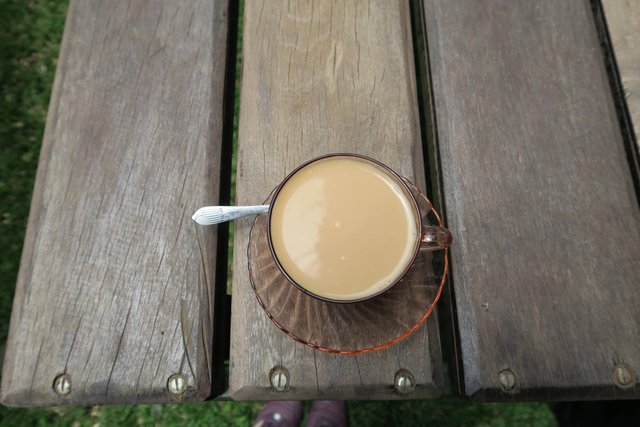
From soil to bean to cup, the story of Kenyan coffee is interesting. The first coffee was introduced in 1893, by Scottish and French missionaries. The rich volcanic soils from the Kenyan highlands and the great weather make coffee thrive. Kenya has some of the best coffee in the world.
In fact, Kenyan Arabica coffee is used to blend other coffees because of its high quality. There are two varieties of coffee and these are the Arabica and Robusta. Robusta is a hardier variety but Arabica is of higher quality. Kenyan Arabica is renowned all over the world because of its rich flavor. You haven’t tasted good coffee until you have tasted coffee from Kenya.
 My friend enjoying a cup
My friend enjoying a cup
My friend, Millicent, works in Fairview Coffee Estate which is one of the estates that offers tours. She invited us for a day trip where we would go to the estate, see how coffee grows, see how it is processed and we would have a coffee tasting session with the barista.
The Estate is 44 Hectares big and they have divided the farms in blocks. They told us that some of the plants were about 2-3 centuries old.
Millicent was a great teacher and she taught us everything we needed to know about growing, harvesting and even marketing the coffee. A coffee tree takes years to grow and there’s constant care for it. Taking care of coffee bushes is not so labor intensive because in such a region, the fact that the soils are volcanic and there is rain means that half the work is already done.
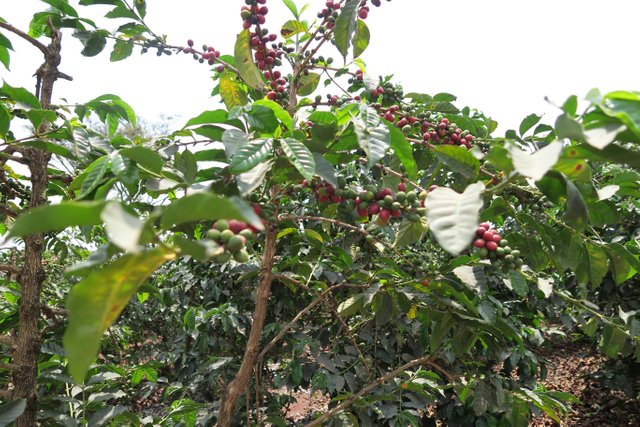 The coffee plant
The coffee plant
 Lime to alter the soil pH. They use this if the soi is too acidic
Lime to alter the soil pH. They use this if the soi is too acidic
However, regular pruning is required. The coffee plant grows as a shrub and it must be pruned when it is young. The farmers leave up to three dominant stems to grow while they cut all the others. This ensures that the plant concentrates all its nutrients to the few stems. If they leave many stems to grow, the plant will become bushy and take all its nutrients to the foliage instead of concentrating it on the fruit. There has been a huge difference between those who prune and those who do not.
They also completely cut the three stems and train 2-3 more. This ensures that the plant remains rigorous.
They also do regular weeding and mulching to ensure the coffee plants have enough water. The Robusta variety is generally very hardy and can rely on rainwater alone. However, the Arabica coffee needs much care and attention.
Processing Coffee
Picking
Most coffee etstates in Kenya employ many people including family units during harvesting. People pick ripe coffee berries from the farm. In most farms, people earn a living when they pick coffee. Their wages are determined by how many containers of coffee berries they pick.

 Coffee cherries/ berries
Coffee cherries/ berries
Sorting
After picking, all the berries are assembled into one place where the coffee workers sort the berries. They separate the ripe and the diseased one. They look for unblemished berries because these will be the best quality ones. They also remove the unripe and overripe berries and throw them away or use them as manure/ compost.
Pulping & Grading
This is done by removing the skin from the beans. Each berry/cherry has two beans inside. After pulping, they get the different beans (seeds) which have hard husks. They sort the beans according to size.
Mucilage
The beans have a sticky mucus-like substance covering them. The slimy substance is removed through fermentation. They feel the beans with their hands after fermentation and if they feel gritty, this is a sign that the mucus is off the husks. This is a great sign to go to the next stage.
Soaking
They then soak the seeds in water and this is said to improve the quality of the coffee. In this process, there is rigorous washing.
Grading
After the thorough washing on the concrete passages, the seeds are graded again depending on the size. They use a lot of water in all these processes.
Drying
After the grading, the coffee is dried under the sun. The workers spread and turn the coffee for even drying. The coffee is spread for days to weeks depending on the month and the temperatures or sunny hours.
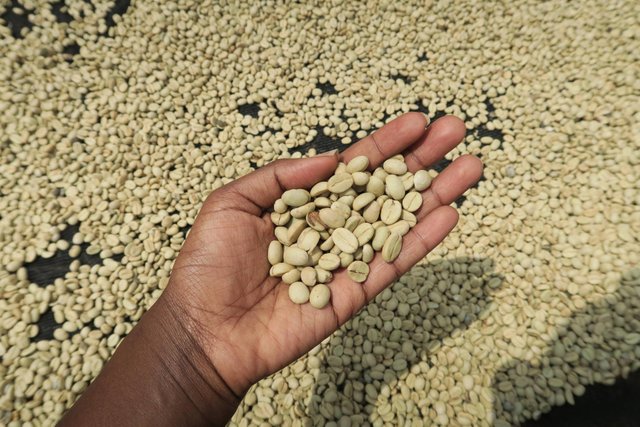
Storing and hulling
This depends on the demand for coffee beans. Hulling/ husking is the removal of the husks to reveal the beans.
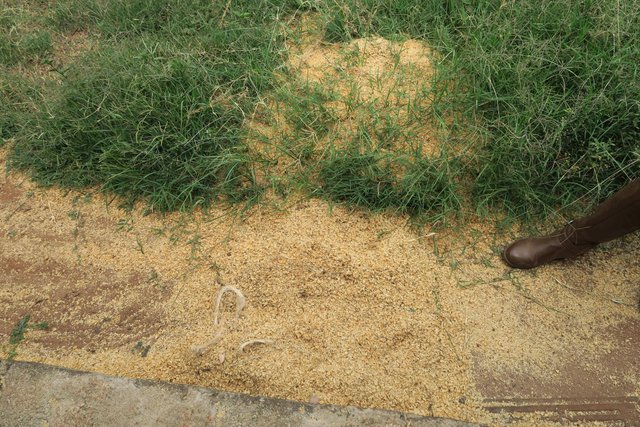 The husks are used as fuel or mulch
The husks are used as fuel or mulch
Grinding and packing
The beans are then ground, packed and labeled for export or sale. Sometimes they are roasted. They also test their coffee in a lab and they have an inhouse barista who helps with deciding the flavours and quality.

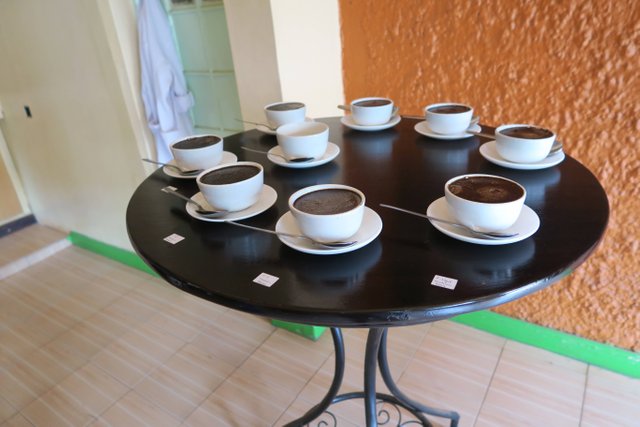 The tasting lab
The tasting lab
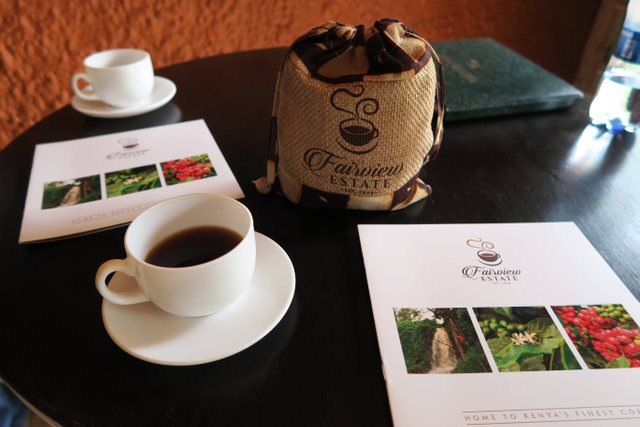 As you can see, they pack them in these cute bags
As you can see, they pack them in these cute bags
 Roasted and ground coffee
Roasted and ground coffee
In Kenya, most of the quality coffee is exported to global coffee chains and it is used to blend or upgrade other coffee varieties.
I remember taking some breaks cooling off by the river during this tour thinking how tired we were. But we soldiered on through the tracts of land and straight rows of coffee. We went to the cow farms and marveled at the cows going about their grass-eating business. We then went to the plantain and banana farms.
Fairview Coffee Estate is very interesting because it is privately owned. The farm is very big and they also practice fruit farming and livestock farming. You can easily tour the whole farm by foot but you will be sweating profusely.

They even have a river passing through the farm and there is a very high waterfall. They also have an indigenous forest towards the edge of the farm where people can hike.
Overall, you have to be prepared to do a lot of hiking when you visit this estate. After the hike, you have a garden picnic at any of their picturesque sites.
 The waterfall
The waterfall
 Hiking with Millicent
Hiking with Millicent

 The indigenous forest undisturbed
The indigenous forest undisturbed
They give you specially made A1 coffee with some Maandazis (African pastry) and some fruit. They also sell coffee at the site in bags that have been made by local women groups that the estate supports. This is one of those trips that stays with you for a long time. We got coffee to carry home and we even got coffee grinds which a great body scrub. I am still using them today. From time to time, I brew myself a perfect cup.

I never knew that a coffee tour would be so tiring. In my mind, I thought that we would only just be visiting a factory seeing how coffee is made but boy was I wrong. No one had warned me that we would be hiking under the scorching January sun. No one had also informed me how big this estate was.
However, looking back, I am glad I toured the whole of it on foot completing it a sweaty mess. There is a sense of pride that comes from finishing things.
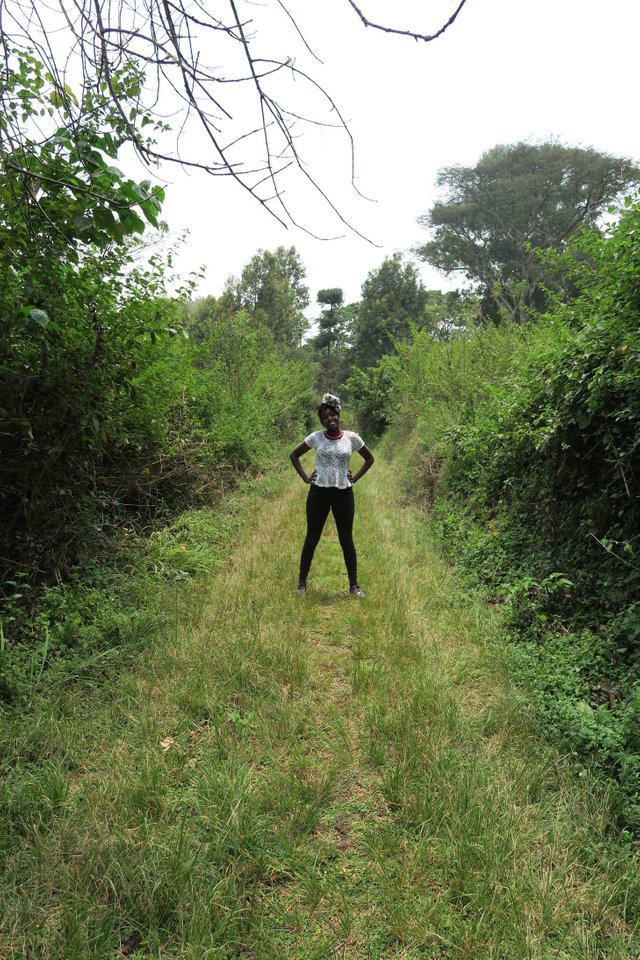
Have you been on a coffee tour and how was it? Let me know down below.
Authored by @jeanwandimi
Photography by @njoromuts & @jeanwandimi
Cameras used Canon g7x and Canon Rebel t5i
Click on the coin to join our Discord Chat
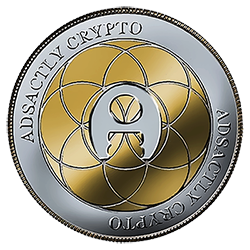
Witness proposal is here:
Go To Steem Witness Page
In the bottom of the page type: adsactly-witness and press vote.

Use small letters and no "@" sign. Or, click here to vote directly!
Thank you!
That is one huge coffee growing estate, and the coffee cultivation process is quite complex and expansive.
The pictures are beautiful too. Love the colors on those coffee berry clusters.
Thank you for sharing this post.
Exactly whats on my mind...cheers
anyone tried Vietnamese coffee with condensed milk or ferret coffee?
Exactly what's on my mind....cheers
Coffee tastes slightly different in every country probably due to different varieties of coffee, weather, soil quality and preparation methods. Brewed coffee in Batangas, Philippines is slightly sweet (Kapeng Barako). Freshly brewed coffee, I think, is the healthiest coffee. But in general, research shows that Coffee is good for your health!
In Aceh you can find better quality coffee, so if you are a coffee maniac, let's me know and join us in Aceh....
Now that's a post, waking up and smelling the coffee.
Coffee tastes slightly different in every country probably due to different varieties of coffee, weather, soil quality and preparation methods. Brewed coffee in Batangas, Philippines is slightly sweet (Kapeng Barako). Freshly brewed coffee, I think, is the healthiest coffee. But in general, research shows that Coffee is good for your health!
I have always wanted to try coffee from the Phillippines. I hear it is delicious.
i agree, i heard its the best from there!
https://steemit.com/animalphotography/@hrisheekrayb/animalphotography-powered-by-juliank
Please once visit my post.
My entry for animalphotography.
wow deep information.. When I was reading this blog, I was thinking how easily we took tea or coffee from the packet and make it, but how we get we never even think. Really good work sir.
Yes most times we forget about the story behind the product.
Hot coffee with @adsactly :)
Sounds like a great name for a possible show. Right?
This is amazing. If you are one of the many arabica coffee addicts. I suggest you to try Gayo Coffee enjoyment. Gayo Coffee is very global, Gayo coffee quality has been proven and tested in the world exhibition organized by the Organization Specialty Coffee Association of America (SCAA) in Portland, Oregon Convention Center, USA. In addition, the Gayo coffee enjoyment also received Fair Trade Certified from International Trade Fair Organization on May 27, 2010, Gayo Coffee received IG certificate (Geographical Indication). Gayo Coffee comes from the Gayo highlands of Central Aceh district of Indonesia. Good luck.
An interesting journey through production of the humble coffee bean. I wonder back in the 17th century when coffee made its way to Europe they ever thought it could become such an integral part of life in the modern world. Millions of people line up each morning to wait for that lovely hit of coffeeness to start their day and probably don't give a thought to the journey that little bean took to get into their cup...But you get to make your own special coffee from your tour!
We haven't been on a coffee tour however it looks like you had a great time on yours. If we get the chance it looks worth the effort. And the bonus is some coffee along the way right? :)
A good post, thank you.
Wow. I had never thought of it like that. It is nice to see how coffee has become an integral part of our world. I am actually typing this as I sip on some.
Some of the best Starbucks coffee from Kenya!
Many of us loves coffee so much that is why coffee shops were proliferating like mushrooms. But i love home-made coffee, pure and strong in taste :)
Please visit my post.
https://steemit.com/animalphotography/@hrisheekrayb/animalphotography-powered-by-juliank
My entry for animalphotography.
By drinking our imagination more steady,
I love a coffee
That is true. So many ways to enjoy coffee too.
"Every dreamer knows that it is entirely possible to be homesick for a place you've never been to, perhaps more homesick than for familiar ground.”
― Judith Thurman